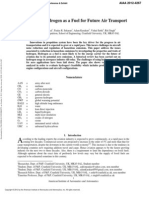0 ratings0% found this document useful (0 votes)
61 viewsLecture 04
Lecture 04
Uploaded by
Saurabh Pancholi1. Gravity anomalies result from local variations in topography and subsurface density and have amplitudes of several mgal.
2. Various corrections must be applied to gravity measurements including tidal, Eötvös, latitude, terrain, Bouguer plate, and free-air corrections.
3. Gravity anomalies can provide information about subsurface density variations and structures. Common models used to interpret anomalies include those of a uniform sphere, infinite line, infinite cylinder, and semi-infinite horizontal sheet.
Copyright:
© All Rights Reserved
Available Formats
Download as PDF, TXT or read online from Scribd
Lecture 04
Lecture 04
Uploaded by
Saurabh Pancholi0 ratings0% found this document useful (0 votes)
61 views8 pages1. Gravity anomalies result from local variations in topography and subsurface density and have amplitudes of several mgal.
2. Various corrections must be applied to gravity measurements including tidal, Eötvös, latitude, terrain, Bouguer plate, and free-air corrections.
3. Gravity anomalies can provide information about subsurface density variations and structures. Common models used to interpret anomalies include those of a uniform sphere, infinite line, infinite cylinder, and semi-infinite horizontal sheet.
Original Description:
cv
Copyright
© © All Rights Reserved
Available Formats
PDF, TXT or read online from Scribd
Share this document
Did you find this document useful?
Is this content inappropriate?
1. Gravity anomalies result from local variations in topography and subsurface density and have amplitudes of several mgal.
2. Various corrections must be applied to gravity measurements including tidal, Eötvös, latitude, terrain, Bouguer plate, and free-air corrections.
3. Gravity anomalies can provide information about subsurface density variations and structures. Common models used to interpret anomalies include those of a uniform sphere, infinite line, infinite cylinder, and semi-infinite horizontal sheet.
Copyright:
© All Rights Reserved
Available Formats
Download as PDF, TXT or read online from Scribd
Download as pdf or txt
0 ratings0% found this document useful (0 votes)
61 views8 pagesLecture 04
Lecture 04
Uploaded by
Saurabh Pancholi1. Gravity anomalies result from local variations in topography and subsurface density and have amplitudes of several mgal.
2. Various corrections must be applied to gravity measurements including tidal, Eötvös, latitude, terrain, Bouguer plate, and free-air corrections.
3. Gravity anomalies can provide information about subsurface density variations and structures. Common models used to interpret anomalies include those of a uniform sphere, infinite line, infinite cylinder, and semi-infinite horizontal sheet.
Copyright:
© All Rights Reserved
Available Formats
Download as PDF, TXT or read online from Scribd
Download as pdf or txt
You are on page 1of 8
GG612 Lecture 4 2/3/11 1
Clint Conrad 4-1 University of Hawaii
LECTURE 4: GRAVITY ANOMALIES AND ISOSTASY
Average gravity on the Earths surface is about g=9.8 m/s
2
, and varies by
~5300 mgal (about 0.5% of g) from pole to equator. (1 mgal=10
-5
m/s
2
)
Gravity anomalies are local variations in gravity that result from topographic and
subsurface density variations, and have amplitudes of several mgal and smaller.
Measurement of Absol ute Gravi ty:
Pendul um Method: Measure the period
!
T = 2"
I
mgh
= 2"
L
g
To measure 1 mgal variation, the period must be measured to within 1s.
Free-fal l Method: Measure the fall of a mass:
!
z = z
0
+ut + gt
2
2
To measure 1 gal variation, time must be measured to within 1ns.
Ri se-and-fal l Method: Measure time T for a thrown ball to rise and fall a
height z:
!
z = g T 2
( )
2
2. Then
!
g =
8 z
1
" z
2 ( )
T
1
2
"T
2
2
( )
. gal precision; not portable.
Measurement of Rel ati ve Gravi ty:
Stabl e Gravi meter: Measure !s, the
change in a springs length:
!
"g =
k
m
"s
Unstabl e Gravi meter: Use a spring with
built-in tension, so:
!
"g =
k
m
s
(LaCost-Romberg gravimeter)
Usage: Adjust the spring length to zero
using a calibrated screw.
Sensi ti vi ty: 0.01 mgal for a portable device.
Superconducti ng Gravi meter: Suspend a niobium sphere in a
stable magnetic field of variable strength. Sensitivity: 1 ngal
GG612 Lecture 4 2/3/11 2
Clint Conrad 4-2 University of Hawaii
Gravi ty Correcti ons
Dri ft Correcti on: In relative gravity surveys, instrument drift can be corrected
by making periodic measurements at a base station with known gravity.
Ti dal Correcti on: Gravity changes during the day due to the tides in a known
way. Tidal corrections can be computed precisely if time is known. For
example, if the moon is directly overhead, the tidal correction would be:
!
"g
T
= G
M
L
r
L
2
2R
E
r
L
+3
R
E
r
L
#
$
%
&
'
(
2
+...
#
$
%
%
&
'
(
(
This should be added to measured gravity.
Etvs Correcti on: Moving eastward at v
E
, your angular velocity increases by:
!
"# = v
E
R
E
cos$
( )
. This change increases the centrigugal acceleration:
!
"a
C
=
da
C
d#
$
%
&
'
(
)
"# = 2#R
E
cos*
( )
v
E
R
E
cos*
$
%
&
'
(
)
= 2#v
E
. Downward gravity changes by:
!
"g = #2$v
E
cos%. The Etvs effect decreases gravity when moving east.
Lati tude Correcti on: Absolute gravity is corrected by subtracting normal
gravity on the reference ellipsoid:
!
g
n
= g
e
1+ "
1
sin
2
# + "
2
sin
4
2#
( )
where
!
g
e
= 9.780327 m/s
2
,
!
"
1
= 5.30244#10
$3
, and
!
"
2
= #5.8$10
#6
.
Relative gravity is corrected by differentiating g
n
with respect to !:
!
"g
lat
= 0.8140sin2# mgal per km north-south displacement. This correction
is subtracted from stations closer to the pole than the base station.
Terrai n Correcti on: Nearby topography perturbs gravity measurements
upward due to mass mass excess above the station (nearby
hills) or due to mass deficiency below the station (nearby valleys). The
terrain correction is computed using:
GG612 Lecture 4 2/3/11 3
Clint Conrad 4-3 University of Hawaii
h
2. remove
layer!"g
BP
1. Drop to
ellipsoid!"g
FA
!
"g = G dmcos#
( )
r
2
+ z
2
( )
where r and z are the horizontal and
vertical distances to dm, and " is the
angle to the vertical. The terrain
correction is always positive.
Integrating over a sector gives:
!
"g
T
= G#$ r
2
+ h
2
% r
1
&
'
(
)
*
+
% r
2
+ h
2
% r
2
&
'
(
)
*
+
&
'
(
)
*
+
r
1
and r
2
are the inner and out radii, h is the height, # is the sector angle.
Bouguer Pl ate Correcti on: This correction compensates for a rock layer of
thickness h between the measurement elevation level and the reference
level. For a solid disk of density $ and radius r, the terrain correction is:
!
"g
T
= 2#G$ h % r
2
% h
2
% r
&
'
(
)
*
+
&
'
(
)
*
+ . Allowing r to become infinite, we obtain:
!
"g
BP
= 2#G$h = 0.0419%10
&3
$ mgal/m if $ is in kg/m
3
.
This correction must be subtracted, unless the station is below sea level
in which case a layer of
rock must be added to
reach the reference level.
For gravity measured over water, water must be replaced with rock
by assigning a slab with density
!
"
rock
- "
water ( )
.
Free-ai r Correcti on: This correction compensates for gravitys decrease with
distance from the Earths surface. It is determined by differentiating g:
!
"g
FA
=
#
#r
$G
M
E
r
2
%
&
'
(
)
*
= +2G
M
E
r
3
= $
2
r
g = 0.3086 mgal/m
This correction must be added (for stations above sea level).
GG612 Lecture 4 2/3/11 4
Clint Conrad 4-4 University of Hawaii
Combi ned Correcti on: Free air and Bouguer corrections are often combined:
!
"g
FA
+ "g
BP
= 0.3086# 0.0419$ %10
#3
( )
mgal/m= 0.197 mgal/m
assuming a crustal density of 2670 kg/m
3
. To obtain 0.01 mgal accuracy:
-- location must be known to within 10 m (for latitude correction)
-- elevation must be known to within 5 cm (for combined correction)
Geoi d Correcti on: For long wavelength surveys, station heights must be
corrected for the difference in gravity between the geoid height and the
reference ellipsoid, which can vary spatially.
Densi ty determi nati on
Knowledge of the density of subsurface rocks is essential for the Bouguer and
terrain corrections. Density can be measured in several ways:
! By measuring the density of rocks on the surface
! Using seismic velocity measurements (velocity increases with density)
! By applying the combined correction to depth variations in gravity
measurements in a borehole. Assuming two measurements are separated
by a height "h and using the lower station as a reference level,
The gravity correction at the upper borehole (free-air decreases
gravity and Bouguer slab between the stations increases gravity) is:
!
"g
upper
= "g
FA
+ "g
BP
= 0.3086# 0.0419$ %10
#3
( )
"h
The gravity correction at the lower borehole (Bouguer slab between
the stations decreases gravity) is:
!
"g
lower
= "g
FA
+ "g
BP
= 0+0.0419# $10
%3
( )
"h
Subtracting the two and solving for density $ gives:
!
" = 3.683#11.93$g $h
( )
%10
#3
km/m
3
GG612 Lecture 4 2/3/11 5
Clint Conrad 4-5 University of Hawaii
Gravi ty Anomal i es
After the appropriate corrections are applied, gravity data reveal information
about subsurface density heterogeneity. How should this data be interpreted?
Gravi ty over a Uni form Sphere
Gravity for a sphere is the same as
for a point mass. The z-component:
!
"g
z
= "gsin# = G
M
r
2
z
r
where
!
M =
4"
3
R
3
#$ and
!
r
2
= z
2
+ x
2
giving:
!
"g
z
=
4#
3
G
"$R
3
z
2
%
&
'
(
)
*
z
2
z
2
+ x
2
%
&
'
(
)
*
3/ 2
The maximum is at x=0, where:
!
"g
zmax
=
4#
3
G
"$R
3
z
2
%
&
'
(
)
*
Rule of thumb:
!
z = 0.65w where w is the width at half height of the anomaly.
Gravi ty over an I nfi ni te Li ne
An infinitely long line of mass m per unit length produces a gravity anomaly:
!
"g
z
=
2Gmz
z
2
+ x
2
where z and x are the vertical and horizontal distances to the line.
Gravi ty over an I nfi ni te Cyl i nder
An infinitely long cylinder is a useful analogue for a buried syncline or anticline.
!
"g
z
= 2#G
"$R
2
z
%
&
'
(
)
*
z
2
z
2
+ x
2
%
&
'
(
)
* and
!
"g
zmax
= 2#G
"$R
2
z
%
&
'
(
)
*
Rule of thumb:
!
z = 0.5w. A structure must be more than 20% longer than it is
wide or deep for the infinite approximation to be valid (ignore edge effects).
GG612 Lecture 4 2/3/11 6
Clint Conrad 4-6 University of Hawaii
x
3/4
#g/4
Gravi ty over a Semi -I nfi ni te Hori zontal Sheet
A horizontally truncated thin sheet can
be used to approximate a bedded
formation offset by a fault. If the fault is
centered at x=0, z
0
=0, then the gravity
anomaly is:
!
"g
z
= 2G"#h
$
2
+ tan
%1
x
z
0
&
'
(
)
*
+
&
'
(
)
*
+
Rule of thumb: z
0
~x
1/4
~x
3/4
Where x
1/4
and x
3/4
are the positions where
the gravity anomaly is " and # its max value.
Note that as x&$,
!
"g
z
= 2G"#h, which is the
solution for a Bouguer Plate anomaly.
Gravi ty anomal y of arbi trary shape
Any shape can be approximated as an n-sided
polygon, the gravity anomaly of which can be
computed using Talwanis algorithm. This
algorithm estimates gravity by
computing a line integral around
the perimeter:
!
"g
z
= 2G"# zd$
%
I sostasy
Long wavelength variations in topography are isostatically compensated at
depth. This means that the excess mass in positive topography is compensated
by a mass deficiency at depth. There are three types of isostasy.
GG612 Lecture 4 2/3/11 7
Clint Conrad 4-7 University of Hawaii
Airy Isostasy
Pratt Isostasy
$
c
$
m
$
m
$
c
C
C
Ai ry I sostasy:
Lateral variations in crustal thickness allow surface topography to be
compensated by a deep crustal root. The thickness of this root is determined by
requiring the mass in columns above the compensation depth (C) to be equal:
!
r
1
=
"
c
"
m
# "
c
h
1
or, if the topography is under water,
!
r
1
=
"
c
# "
w
"
m
# "
c
h
1
Pratt I sostasy:
Lateral variations in crustal density compensate topography, so again the mass
in columns above the compensation depth (C) are equal. The density is:
!
"
1
=
D
h
1
+D
"
c
or, if the column is a depth d under water,
!
"
0
=
"
c
D# "
w
d
D# d
Veni ng Mei nesz I sostasy:
In this type of isostasy,
short-wavelength topography
is supported by the elastic
strength of the crustal
rocks. The load is instead
distributed by the bent plate
over a broad area. This
distributed load is compensated.
GG612 Lecture 4 2/3/11 8
Clint Conrad 4-8 University of Hawaii
Gravi ty Anomal i es over Topography
Uncompensated topography (Short-wavelengths)
Free-air anomaly (apply the free-air correction only):
"g+"g
FA
>> 0 because of the topographys excess mass
Bouguer anomaly (apply both free-air and Bouguer plate corrections):
"g+"g
FA
-"g
BP
~ 0 because Bouguer corrects for excess mass.
Compensated topography (Long-wavelengths)
Free-air anomaly (apply the free-air correction only):
"g+"g
FA
~ 0 because topography is compensated (no excess mass)
Bouguer anomaly (apply both free-air and Bouguer plate corrections):
"g+"g
FA
-"g
BP
<< 0 because Bouguer removes additional mass.
Undercompenstated topography: A too-shallow root, yields "g+"g
FA
>0
Overcompensated topography: A too-shallow root, yields "g+"g
FA
<0
Geoi d Anomal i es over Topography
The gravitational acceleration can be approximated as:
!
g = "
#U
#r
$U =
$U
$N
where "N is the change in geoid height
We can approximate the change in potential as:
!
g"N ~ "U ~ # "gdz
0
z
c
$
= # 2%Gz"& z
( )
dz
0
z
c
$
where z is positive downwards from the
surface to the compensation depth z
c
Then the geoid height can be written as:
!
"N ~ #
2$G
g
0
z"% z
( )
dz
0
z
c
&
This is non-zero because
!
"# z
( )
dz
0
h
$
= 0 for isostasy.
Thus, the geoid anomaly should be positive over compensated positive
topography (e.g., the continental lithosphere, mid-ocean ridges, Tibet, Andes)
The geoid gives better constraints on the depth-distribution of mass than does
gravity.
You might also like
- The Subtle Art of Not Giving a F*ck: A Counterintuitive Approach to Living a Good LifeFrom EverandThe Subtle Art of Not Giving a F*ck: A Counterintuitive Approach to Living a Good LifeRating: 4 out of 5 stars4/5 (6026)
- The Gifts of Imperfection: Let Go of Who You Think You're Supposed to Be and Embrace Who You AreFrom EverandThe Gifts of Imperfection: Let Go of Who You Think You're Supposed to Be and Embrace Who You AreRating: 4 out of 5 stars4/5 (1133)
- Never Split the Difference: Negotiating As If Your Life Depended On ItFrom EverandNever Split the Difference: Negotiating As If Your Life Depended On ItRating: 4.5 out of 5 stars4.5/5 (911)
- Grit: The Power of Passion and PerseveranceFrom EverandGrit: The Power of Passion and PerseveranceRating: 4 out of 5 stars4/5 (628)
- Hidden Figures: The American Dream and the Untold Story of the Black Women Mathematicians Who Helped Win the Space RaceFrom EverandHidden Figures: The American Dream and the Untold Story of the Black Women Mathematicians Who Helped Win the Space RaceRating: 4 out of 5 stars4/5 (938)
- Shoe Dog: A Memoir by the Creator of NikeFrom EverandShoe Dog: A Memoir by the Creator of NikeRating: 4.5 out of 5 stars4.5/5 (548)
- The Hard Thing About Hard Things: Building a Business When There Are No Easy AnswersFrom EverandThe Hard Thing About Hard Things: Building a Business When There Are No Easy AnswersRating: 4.5 out of 5 stars4.5/5 (359)
- Her Body and Other Parties: StoriesFrom EverandHer Body and Other Parties: StoriesRating: 4 out of 5 stars4/5 (831)
- Elon Musk: Tesla, SpaceX, and the Quest for a Fantastic FutureFrom EverandElon Musk: Tesla, SpaceX, and the Quest for a Fantastic FutureRating: 4.5 out of 5 stars4.5/5 (481)
- The Emperor of All Maladies: A Biography of CancerFrom EverandThe Emperor of All Maladies: A Biography of CancerRating: 4.5 out of 5 stars4.5/5 (275)
- The Little Book of Hygge: Danish Secrets to Happy LivingFrom EverandThe Little Book of Hygge: Danish Secrets to Happy LivingRating: 3.5 out of 5 stars3.5/5 (434)
- The Yellow House: A Memoir (2019 National Book Award Winner)From EverandThe Yellow House: A Memoir (2019 National Book Award Winner)Rating: 4 out of 5 stars4/5 (99)
- Devil in the Grove: Thurgood Marshall, the Groveland Boys, and the Dawn of a New AmericaFrom EverandDevil in the Grove: Thurgood Marshall, the Groveland Boys, and the Dawn of a New AmericaRating: 4.5 out of 5 stars4.5/5 (273)
- The World Is Flat 3.0: A Brief History of the Twenty-first CenturyFrom EverandThe World Is Flat 3.0: A Brief History of the Twenty-first CenturyRating: 3.5 out of 5 stars3.5/5 (2283)
- The Sympathizer: A Novel (Pulitzer Prize for Fiction)From EverandThe Sympathizer: A Novel (Pulitzer Prize for Fiction)Rating: 4.5 out of 5 stars4.5/5 (125)
- A Heartbreaking Work Of Staggering Genius: A Memoir Based on a True StoryFrom EverandA Heartbreaking Work Of Staggering Genius: A Memoir Based on a True StoryRating: 3.5 out of 5 stars3.5/5 (233)
- Team of Rivals: The Political Genius of Abraham LincolnFrom EverandTeam of Rivals: The Political Genius of Abraham LincolnRating: 4.5 out of 5 stars4.5/5 (235)
- On Fire: The (Burning) Case for a Green New DealFrom EverandOn Fire: The (Burning) Case for a Green New DealRating: 4 out of 5 stars4/5 (75)
- History of PRMSDocument10 pagesHistory of PRMSSaurabh Pancholi100% (1)
- The Unwinding: An Inner History of the New AmericaFrom EverandThe Unwinding: An Inner History of the New AmericaRating: 4 out of 5 stars4/5 (45)
- Soil Analysis Lab Report CHE332Document6 pagesSoil Analysis Lab Report CHE332farenfarhan5No ratings yet
- Result SOT - Civil Engg 4th Sem-NewDocument6 pagesResult SOT - Civil Engg 4th Sem-NewSaurabh PancholiNo ratings yet
- Types of CompletionDocument27 pagesTypes of CompletionSaurabh PancholiNo ratings yet
- Fertilizer Association/Company Website AddressDocument1 pageFertilizer Association/Company Website AddressSaurabh PancholiNo ratings yet
- CBSE Class 6 General Science Practice WorksheetsDocument2 pagesCBSE Class 6 General Science Practice Worksheetsfgh ijkNo ratings yet
- Midterm Review 1 Grade 9 5f5a4Document5 pagesMidterm Review 1 Grade 9 5f5a4phthkimtienNo ratings yet
- Physico Chemical Parameter of River Ajnal at Harda M.P.Document3 pagesPhysico Chemical Parameter of River Ajnal at Harda M.P.Editor IJTSRDNo ratings yet
- Prin. Geo 02 MASS WASTING (Autosaved)Document104 pagesPrin. Geo 02 MASS WASTING (Autosaved)Åň ĞëłNo ratings yet
- Iecep Compilation GeasDocument4 pagesIecep Compilation Geasjanno2101100% (1)
- Refrigeration: Cooling Production EquipmentDocument8 pagesRefrigeration: Cooling Production EquipmentrachelleNo ratings yet
- 06 - Atomic PhysicsDocument12 pages06 - Atomic Physicsshaikarshad200706No ratings yet
- Yusay, Rojielynne T. Grade 11 - AQUILA: Disaster Readiness and Risk Reduction Quarter 2 - Module 7Document2 pagesYusay, Rojielynne T. Grade 11 - AQUILA: Disaster Readiness and Risk Reduction Quarter 2 - Module 7Ennyliejor YusayNo ratings yet
- Climate Variability and Climate Change 2016Document91 pagesClimate Variability and Climate Change 2016Laila Guarin100% (1)
- Porosity LogsDocument152 pagesPorosity LogsMuhammad shahbazNo ratings yet
- Movements of The Earth - Rotation and RevolutionDocument10 pagesMovements of The Earth - Rotation and Revolutionmanelyn mansibangNo ratings yet
- Final Year Project IdeaDocument4 pagesFinal Year Project IdeaSahathullah AhamedNo ratings yet
- Boiler Efficiency at Part Load ConditionsDocument4 pagesBoiler Efficiency at Part Load ConditionsFORBESMARSHALLPVTLTD100% (1)
- Stucture DeterminationDocument7 pagesStucture DeterminationFiaz medicoNo ratings yet
- Biogeochemical CyclesDocument18 pagesBiogeochemical CyclesNicole OngNo ratings yet
- Magnetic RefirgerationDocument57 pagesMagnetic RefirgerationCh V S RajuNo ratings yet
- S1 2014 283541 BibliographyDocument6 pagesS1 2014 283541 BibliographyizzahtulNo ratings yet
- Madeleine Varkay - Developing EE Finance For IndonesiaDocument12 pagesMadeleine Varkay - Developing EE Finance For IndonesiaAsia Clean Energy ForumNo ratings yet
- Ers EDocument16 pagesErs ERdy SimangunsongNo ratings yet
- Me 303 CH11Document45 pagesMe 303 CH11Osman KutluNo ratings yet
- Study of Diffusion of Solids in LiquidsDocument11 pagesStudy of Diffusion of Solids in Liquidsshivyamishra75% (8)
- Paper2 PadmajaDocument8 pagesPaper2 PadmajapratignaNo ratings yet
- Wave Properties RevisedDocument22 pagesWave Properties Revisedapi-260139652No ratings yet
- FebruDocument1 pageFebruNikola SpasicNo ratings yet
- Heat FlashcardsDocument3 pagesHeat Flashcardsapi-345686634No ratings yet
- Seminar ReportDocument15 pagesSeminar ReportMahesh gpNo ratings yet
- Paint Booth HVAC Control SystemDocument6 pagesPaint Booth HVAC Control SystemPraveenkumar KashyabNo ratings yet
- SchmittDocument4 pagesSchmittMartin GriffinNo ratings yet
- H2 in AircraftDocument12 pagesH2 in AircraftAnvesh KadimiNo ratings yet










































































